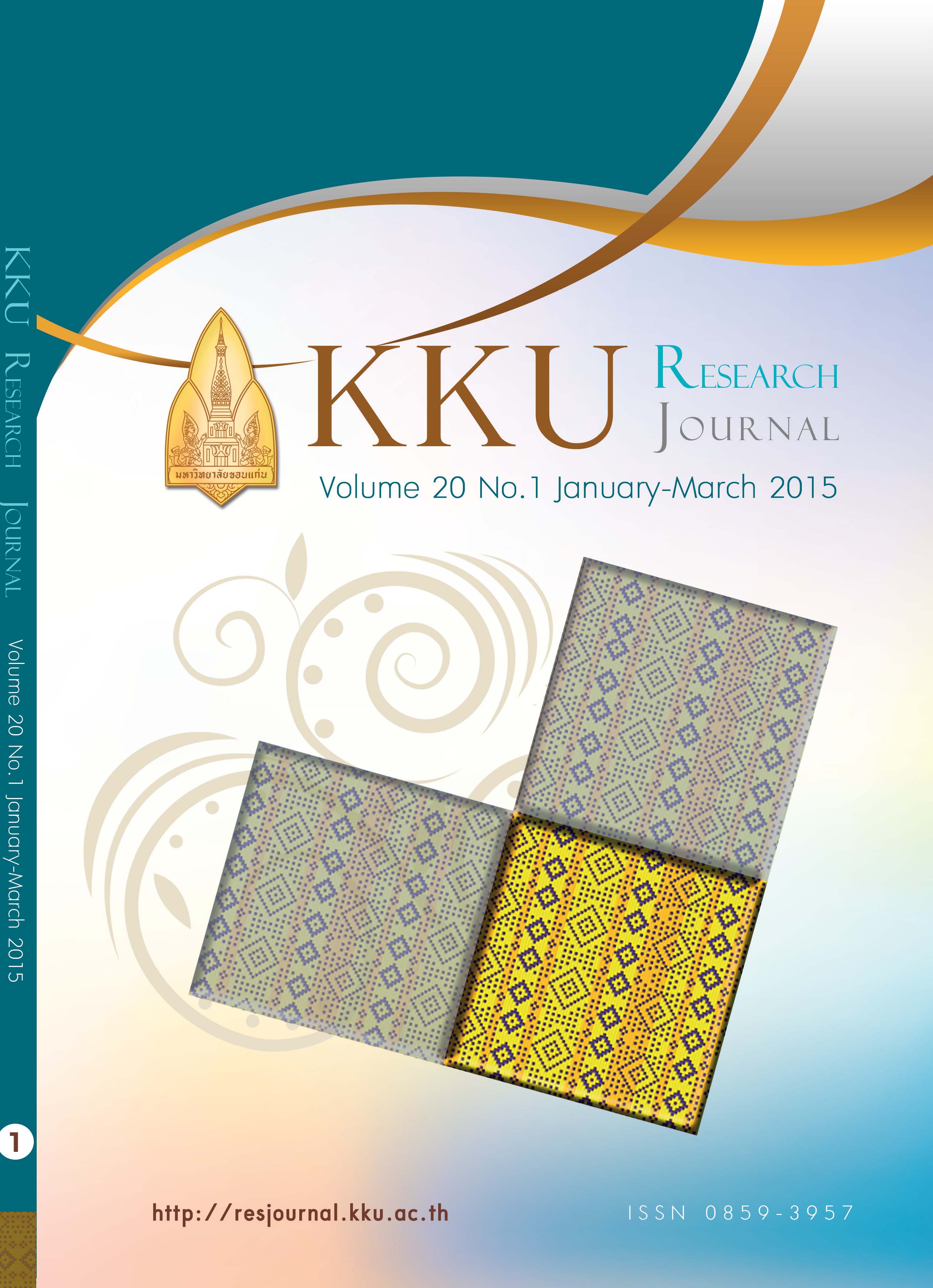Determination of lipophilic and hydrophilic antioxidant activities in the crude extracts of ten varieties of tomatoes
Main Article Content
Abstract
In this study, both lipophilic and hydrophilic antioxidant activities in ten varieties of tomato (Lycopersicon esculentum Mill.) crude extracts were determined using three common assays, namely 2,2-diphenyl-1-picryl-hydrazyl (DPPH), 2,2'-azinobis(3-ethylebenzothiaziline-6-sulfonate) (ABTS) and ferric reducing antioxidant power (FRAP). All the tomato samples exhibited the same activity as that of Trolox. The highest total antioxidant activity (both lipophilic and hydrophilic antioxidant) was found in Black Cherry Kham Kaen while that of Mo Kho 40 sample was the lowest. The average values in terms of TEAC were 910.2, 989.4 and 1174 as determined by ABTS, DPPH and FRAP, respectively. These results demonstrated the potential role of high antioxidant property found in all tomato samples
Article Details
References
[2] Havsteen B. Flavonoids, a class of natural products of high pharmacological potency. Biochemical Pharmacology 1983;32: 1141-1148.
[3] Hudson BJF, Lewis JI. Polyhydroxy flavonoid antioxidants for edible oils. structural criteria for activity. Food Chemistry 1983;10: 47-55.
[4] Takahama U. Inhibition of lipoxygenase-dependent lipid peroxidation by quercetin: Mechanism of antioxidative function. Phytochemistry 1985;24: 1443-1446.
[5] Wang H, Cao G, Prior RL. Total Antioxidant Capacity of Fruits. Journal of Agricultural and Food Chemistry 1996;44: 701-705.
[6] Takeoka GR, Dao L, Flessa S, Gillespie DM, Jewell WT, Huebner B, Bertow D, Ebeler SE. Processing effects on lycopene content and antioxidant activity of tomatoes. Journal of Agricultural and Food Chemistry 2001;49: 3713-3717.
[7] Yao D, Vlessidis AG, Evmiridis NP, Zhou Y, Xu S, Zhou H. Novel chemiluminescence method for detection of superoxide anions and its application to dry-cured meat. Analytica Chimica Acta 2002;467: 145-153.
[8] Pernice R, Parisi M, Giordano I, Pentangelo A, Graziani G, Gallo M, Fogliano V, Ritieni A. Antioxidants profile of small tomato fruits: Effect of irrigation and industrial process. Scientia Horticulturae 2010;126: 156-163.
[9] Arts MJTJ, Sebastiaan Dallinga J, Voss H-P, Haenen, G R M M, Bast A. A critical appraisal of the use of the antioxidant capacity (TEAC) assay in defining optimal antioxidant structures. Food Chemistry 2003;80: 409-414.[10]Rebiai A, Lanez T. Chemical composition and antioxidant activity of Apis Mellifera bee pollen from northwest algeria. Journal of Fundamental and Applied Sciences 2012;4: 26-35.
[11] Vallverdú-Queralt A, Medina-Remón A, Casals-Ribes I, Lamuela-Raventos RM. Is there any difference between the phenolic content of organic and conventional tomato juices?. Food Chemistry 2012;130: 222-227.[12]Thaipong K, Boonprakob U, Crosby K, Cisneros-Zevallos L, Hawkins Byrne D. Comparison of ABTS, DPPH, FRAP, and ORAC assays for estimating antioxidant activity from guava fruit extracts. Journal of Food Composition and Analysis 2006;19: 669-675.
[13] Hossaina MB, Bruntonb NP, Barry-Ryana C, Martin-Dianaa AB, Wilkinsonc M. Antioxidant activity of spice extracts and phenolics in comparison to synthetic antioxidants. Rasayan Journal of Chemistry 2008; 1, 751-756.[14]Li H, Deng Z, Wu T, Liu R, Loewen S, Tsao R. Microwave-assisted extraction of phenolics with maximal antioxidant activities in tomatoes. Food Chem 2012;130: 928-936.
[15] Biacs PA, Daood HG, Czinkotai B, Hajdu F, Kiss-Kutz N. Effect of Titavit treatment on the dynamics of tomato fruit ripeness. Acta Horticulturae 1988;220: 433-438.
[16] Burton GW, Joyce A, Ingold KU. Is vitamin E the only lipid-soluble, chain-breaking antioxidant in human blood plasma and erythrocyte membranes?. Archives of Biochem-istry and Biophysics 1983;221: 281-290.


